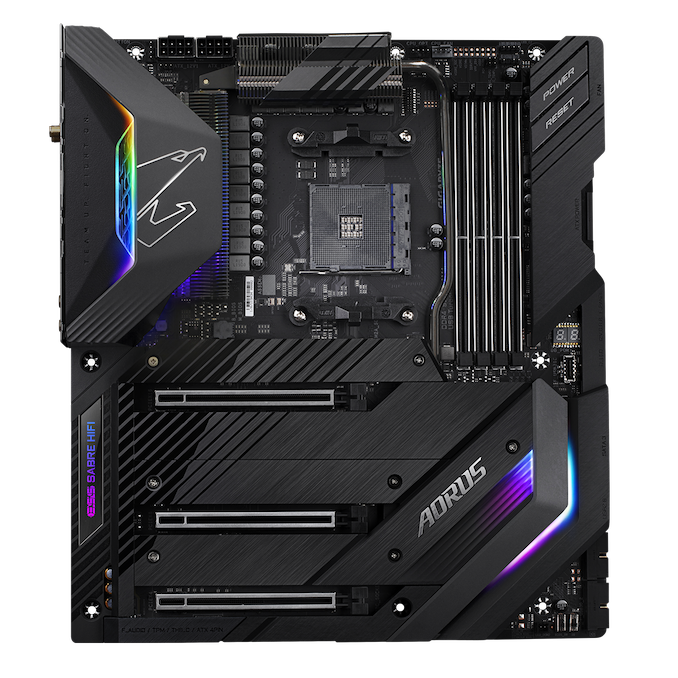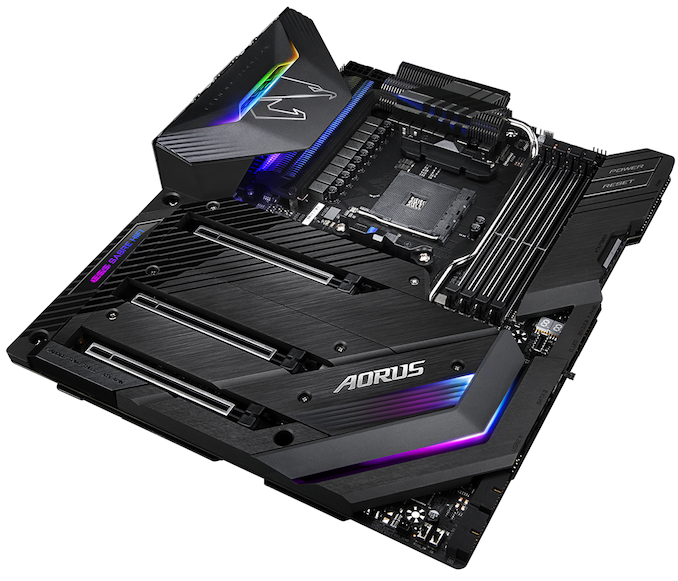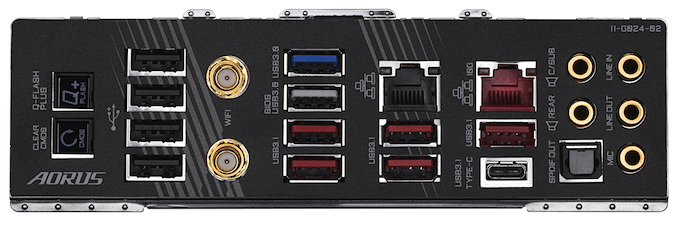The AMD X570 Motherboard Overview: Over 35+ Motherboards Analyzed
by Gavin Bonshor on July 9, 2019 8:00 AM ESTGIGABYTE X570 Aorus Xtreme
Moving onto GIGABYTE's launch day X570 product stack, and it seems to have upped the ante in a number of areas over the previous X470 generation of motherboards. Firstly, GIGABYTE has done a slightly different approach with its power delivery configurations; on paper, they look much higher spec than on previous AM4 models. One prime example of this is in the GIGABYTE X570 Aorus Xtreme which as it stands, is the brand's current flagship model, and is feature-packed with numerous premium componentry, as well as a beefy 16-phase power delivery for the CPU. The other unique feature for the X570 Aorus Xtreme is it's currently the only X570 model at launch to passively cool the warm running X570 chipset.
The X570 Aorus Xtreme is the current flagship from GIGABYTE with a large looking 16-phase power delivery for users looking to overclock the latest Ryzen 3000 series processors, as well as a solid high-end feature set. Across the majority of the PCB, we get Aorus themed armor with three PCIe 4.0 x4 M.2 slots each with its own heatsink which moulds into the PCB cover. There are also six SATA ports with support for RAID 0, 1 and 10 arrays. The CPU VCore section of the power delivery uses two 8-pin 12 V CPU power inputs to deliver power to the processor.
The chipset heatsink onboard the X570 Aorus Xtreme is also one of the only models so far that relies on passive cooling which is interesting as we know the X570 chipset will run with two variants, an 11 W and 15 W. On the rear panel cover is an Aorus Falcon design, with multiple areas with RGB LEDs that users can customize with the Aorus RGB Fusion software. In the top right-hand corner is a power and reset switch, with a small debug LED, and front panel USB 3.1 G2 Type-C port. There are three full-length PCIe 4.0 slots with no PCIe 4.0 x1 slots featured on this model. One of the aspects GIGABYTE is known for focusing on with its high-end models is the onboard audio solution. Adding to the implementation of a Realtek ALC1220 HD audio codec is an ESS Sabre 9218 DAC, with WIMA audio capacitors.
On the rear panel is a large number of inputs and outputs which includes five USB 3.1 G2 Type-A, one USB 3.1 G2 Type-C, two USB 3.1 G1 Type-A, and four USB 2.0 ports. There are two antenna connectors for the integrated Intel AX200 Wi-Fi 6 802.11ax wireless interface, as well as two Ethernet ports which are powered by an Aquantia AQC107 10 G, and Intel I211-AT Gigabit NIC pairing. The Realtek ALC1220-VB HD audio codec adds five 3.5 mm audio jacks and an S/PDIF optical output. Also featured is a clear CMOS switch and Q-Flash Plus BIOS flashing button.
The GIGABYTE X570 Aorus Xtreme is a fine example of what vendors can do for its flagship models on the X570 chipset with plenty of USB 3.1 G2 ports on the rear panel. Dual networking with a 10 G NIC, Wi-Fi 6 capability, and 16-phase power delivery for the CPU make the X570 Aorus Xtreme very attractive. This model has an MSRP of $699 which represents the top end of the X570 product stack at launch, but with everything on offer, it was always expected to be expensive.













225 Comments
View All Comments
mikato - Thursday, July 11, 2019 - link
That’s great to hear. I wonder why they don’t put a decent heatsink on there like they did a long time ago (Penguin 4 days maybe). Is it still too much heat for a big heatsink with no fan?Makaveli - Tuesday, July 9, 2019 - link
Thank you for this round up and more importantly the summary page at the end.I think I going with the ASUS Prime X570-Pro for my build, its the most affordable in CAD.
Never was interested in Wifi on a Desktop PC yuck and the rest if just way too over priced.
I do like the simple look of the ASUS Pro WS X570-Ace but for $500 CAD not interested at that price you might aswell go Threadripper.
Andy Chow - Tuesday, July 9, 2019 - link
I still don't understand why all these boards have HDMI and/or DP on them. Virtually every Intel consumer CPU has an iGPU in it, so it makes sense there. For AMD, I want MOAR CORES, not an iGPU. So that's 1-2 ports that will never get used, which could have been a couple of usb-3 ports.Qasar - Tuesday, July 9, 2019 - link
i bet they are for future zen 2 based APUs....Qasar - Tuesday, July 9, 2019 - link
or current ones for that matterDeath666Angel - Wednesday, July 10, 2019 - link
Because AMD also has iGPU enabled CPUs (which they call APUs). And economies of scale being what they are, this makes more sense than having separate SKUs. Also, do you actually use up all 8 to 12 USB ports on the back?The_Assimilator - Wednesday, July 10, 2019 - link
It's so that the manufacturers can get more negative reviews on online shopping sites. "I BOUGHT THIS BOARD BECAUSE IT HAS DISPLAY OUTPUTS BUT THEY DON'T WORK SO I'M GIVING IT 1 STAR EVEN THOUGH I DIDN'T BOTHER TO DO THE 5 MINUTES OF RESEARCH IT WOULD'VE TAKEN TO EDUCATE MYSELF AS TO WHAT I NEED FOR THE DISPLAY OUTPUTS TO WORK".I agree with you that more USB ports instead would be a lot more useful.
mikato - Thursday, July 11, 2019 - link
Upvoteboozed - Tuesday, July 9, 2019 - link
The last page is a godsend, more of this kind of thing please!NOTELLN - Tuesday, July 9, 2019 - link
This data is wrong. These are not the proper core counts. For example, the International Rectifier IR35201 PWM controller can only do 8+0, 7+1, or 6+2, making the MSI pro and gaming plus 4+2 phase boards. You boys need to go back to the drawing board.